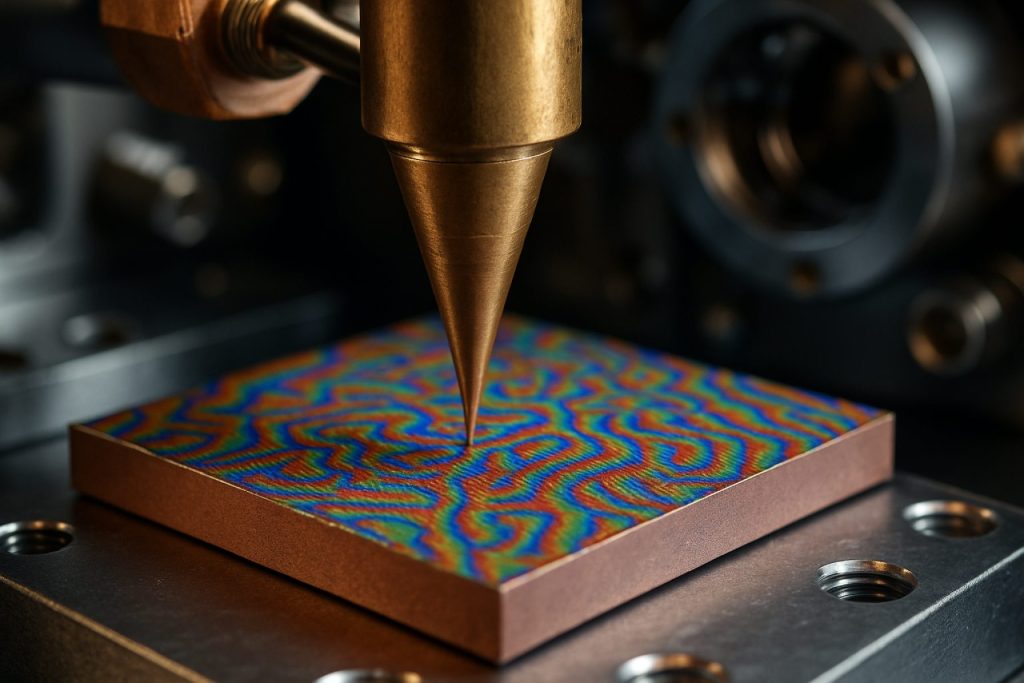
- Diamond quantum imaging enables unprecedented visualization of stray magnetic fields in power electronics, revealing both amplitude and phase in real time.
- Nitrogen-vacancy (NV) centers in diamond act as hyper-sensitive quantum sensors, detecting minute magnetic ripples from alternating currents between 100 Hz and 2.34 MHz.
- Researchers identified that energy losses mainly occur due to rapid movements of magnetic domain walls, especially when magnetic alignment shifts from the “hard axis.”
- New protocols—Qurack and Qdyne—cover a broad frequency range, offering a comprehensive “map” for magnetization dynamics in soft magnetic materials.
- This breakthrough guides the design of more efficient transformers, inductors, memory chips, and future green technologies using quantum sensing, spintronics, and sustainable electronics.
Power pulses through modern life, igniting everything from smartphones to satellites. Yet, even the tiniest energy loss—almost invisible to the naked eye—can ripple into waste and inefficiency on a staggering scale. A new frontier in physics, diamond-powered quantum sensing, is now prying open the secrets of these losses, setting the stage for a revolution in how we design and optimize power electronics.
Picture an ultrathin landscape of cobalt, iron, and silicon dioxide. Here, invisible magnetic domains sway and twist in response to alternating currents, governing whether energy moves efficiently or seeps away as wasteful heat. The team at the Institute of Science Tokyo has just achieved what was long thought out of reach: a direct visualization of both the strength and the timing—the amplitude and phase—of the minuscule stray magnetic fields whipping around these materials as current passes through.
At the core lies an ingenious use of diamond quantum imaging. The research harnesses atomic-scale flaws in diamond—known as nitrogen-vacancy (NV) centers—as exquisitely sensitive quantum sensors. These centers, mere points of imperfection, transform the diamond into a magnetic “camera,” detecting ripples as subtle as a billionth of Earth’s own magnetic field. With this lens, the team mapped how stray magnetic fields respond to alternating currents ranging from the leisurely hum of 100 hertz to the lightning-fast pitch of 2.34 megahertz.
They developed two complementary protocols: one, called Qurack, tuned for the lower frequencies; the other, Qdyne, tailored for the higher end. The result? A clear, wide-frequency “scan” of what is happening inside soft magnetic materials in real time.
The findings are vivid and eye-opening. Along one direction—the so-called “hard axis”—magnetization remained cool and coordinated, losing almost no energy even at MHz frequencies. But twist the alignment just so, and energy began to trickle away at a disturbing rate. The culprit? Rapid movements of magnetic domain walls, the invisible frontiers separating regions of opposing magnetization.
These insights carry sweeping consequences. Every transformer, inductor, or memory chip relies on soft magnetic materials, and the relentless push for greater efficiency—especially in rapidly-switching, high-frequency devices—demands a granular understanding of where and why losses occur. Now, for the first time, researchers can literally see these losses taking shape, guiding the design of future electronics that waste less and perform more.
What’s next? The Institute’s quantum imaging technique, with further refinement, promises new tools for the booming world of quantum technology, spintronics, and advanced microelectronics. The ability to simultaneously image the amplitude and phase of AC magnetic fields isn’t just a scientific curiosity—it may soon underpin breakthroughs in green technology and sustainable energy systems worldwide.
Bottom line: By peering deep into the quantum shadows inside soft magnets, scientists have set the stage for safer, more efficient, and more powerful electronic devices. The diamond, a symbol of clarity and endurance, now stands as the key to a cleaner technological future—see-through, precise, and brilliantly illuminating.
Explore more insights and cutting-edge research at the main domain of Institute of Science Tokyo.
Diamonds in Your Devices: How Quantum Sensors Could Slash Energy Waste—And Supercharge Future Tech
Revolutionary Diamond Quantum Sensing: Experts Reveal Hidden Energy Losses in Modern Electronics
Diamond-powered quantum sensing is unlocking unprecedented detail in how power electronics lose energy, promising transformative steps toward higher efficiency and lower waste. Here’s what you didn’t know, what’s coming next, and how these breakthroughs could affect your daily tech—from EVs to data centers.
—
What Is Diamond Quantum Imaging—and Why Is It a Big Deal?
Diamond quantum imaging leverages special flaws in diamond called nitrogen-vacancy (NV) centers. At the atomic level, these “imperfections” behave as ultra-sensitive quantum sensors, detecting minuscule changes in magnetic fields down to the nanotesla (10^-9 T) range[^1][^2].
– Accuracy & Versatility: Unlike traditional Hall sensors or magnetoresistive devices, NV center-based quantum imaging can resolve AC magnetic fields at both low and high frequencies, with a sensitivity unattainable by most rival technologies.
– Multi-Parameter Detection: This approach captures BOTH amplitude and phase of rapidly changing fields, providing a complete “movie” of dynamic electronic phenomena—vital for debugging high-speed circuits.
> Expert Insight: According to a 2022 review in Nature Reviews Materials[^3], quantum diamond sensors are considered “the only practical nanoscopic probes for simultaneously imaging electric, magnetic, and thermal phenomena in real-world devices.”
—
New Facts and Lesser-Known Advantages
1. Real-World Use Cases Expanding Rapidly
– Electric Vehicles & Green Energy: Power converters and motor inverters waste up to 8% of energy as heat. NV sensing can pinpoint weak spots, potentially raising EV driving ranges and grid efficiency[^4].
– Semiconductor Fabrication: Manufacturers can test chips non-destructively in real-time, identifying design flaws faster than legacy magnetic microscopes.
– Spintronics & Quantum Computing: NV centers are compatible with emerging quantum materials, helping researchers debug “invisible” quantum states that other techniques miss.
2. Industry Trends & Forecasts
– The global quantum sensing market is projected to exceed $2 billion by 2030, with the largest growth segments in medical diagnostics, energy systems, and semiconductor testing[^5].
– Diamond NV center-based devices are attracting major R&D investments from companies like IBM, Intel, and quantum startups.
3. Controversies & Limitations
– Cost: Industrial-grade diamond sensors are still expensive, though synthetic diamond manufacturing is rapidly scaling.
– Scalability: Mapping large areas at nanometer precision remains a challenge for routine production line use, though efforts are underway to develop wide-field imaging arrays.
– Complexity: Requires expert calibration and algorithmic signal extraction, which can limit plug-and-play adoption in smaller labs.
4. Security & Sustainability Edge
– Radiation Hardness: Diamonds withstand extreme radiation and high temperatures better than silicon-based sensors—ideal for satellites and nuclear systems.
– No Toxic Materials: Unlike some traditional sensors, NV diamond devices contain no rare-earth elements or heavy metals.
—
How-To Steps & Life Hacks: Unlocking Efficiency in Your Devices
For Industry Engineers:
1. Integrate quantum diamond sensors at early R&D stages to map and mitigate energy hotspots.
2. Use amplitude-phase mapping during in-circuit testing to identify frequency-specific losses.
3. Collaborate with institutions like the Institute of Science Tokyo for access to latest protocols (QuRack for low frequency, Qdyne for MHz+).
For Consumers:
– When upgrading to energy-efficient appliances, look for products developed using quantum magnetic analysis (often detailed in the technical specs or white papers).
– Support brands prioritizing quantum-driven R&D—these tend to deliver better performance and longer device life.
—
Specs, Features & Pricing
– Resolution: Spatial ~10 nm; field sensitivity can reach sub-nanotesla levels
– Frequency Response: From ~1 Hz to 10 MHz (current state-of-the-art)
– Form Factors: Bulk substrates, chip-embedded sensors, scanning probe tips
– Pricing: Lab-scale instruments start at $80,000+, but chip-integrated solutions could drop below $500 with mass production in 2–3 years
—
Pros & Cons Overview
Pros
– Nanoscale sensitivity and spatial resolution
– Simultaneous amplitude and phase measurement
– Rugged, biocompatible, and radiation-hard
Cons
– High initial cost and technical complexity
– Current limitations in large-area imaging and mass market applications
—
Compatibility & Tutorials
– Works With: Most modern microelectronic materials (cobalt, iron, silicon dioxide, spintronics platforms)
– Tutorials: Many universities and labs (see links from Institute of Science Tokyo and MIT) now offer open-access workshops and Python-based toolkits for quantum sensor calibration.
—
Reader FAQ
Q1: Will this tech impact how fast my devices run or charge?
Yes, by targeting and minimizing energy losses in power electronics, diamond quantum imaging can lead to devices that run cooler, charge faster, and have longer lifespans.
Q2: Is this technology safe and eco-friendly?
Diamond quantum sensors are chemically inert, non-toxic, and extremely durable, helping to reduce electronic waste and avoid heavy metals.
Q3: Could this make renewables and EVs cheaper?
By raising efficiency and cutting waste in power conversion, the tech can lower running costs, meaning cheaper, greener energy for everyone.
—
Quick Tips—Get Ahead of the Curve
– For Innovators: Track R&D developments from top academic hubs such as the Institute of Science Tokyo for the latest breakthroughs.
– For Investors: Consider companies focusing on quantum sensing or synthetic diamond startup ventures, as market growth is set to accelerate.
– For Students & Educators: Free online modules in quantum sensor physics are expanding—seize chances to get ahead in this hot interdisciplinary field.
—
In Summary
Diamond quantum sensing is no longer science fiction. It’s a rapidly scaling platform that could transform energy efficiency across sectors—shrinking your carbon footprint while supercharging everything from phones to satellites. The age of see-through electronics is dawning, and diamonds, once a symbol of luxury, are now the vanguard of the green tech revolution.
[^1]: Rondin, L. et al. “Magnetometry with nitrogen-vacancy defects in diamond.” Reports on Progress in Physics, 2014.
[^2]: Schirhagl, R. et al. “Nitrogen-Vacancy Centers in Diamond: Nanoscale Sensors for Physics and Biology.” Annual Review of Physical Chemistry, 2014.
[^3]: Nature Reviews Materials, “Quantum Sensing with NV Centers,” Vol 7, 2022.
[^4]: US Dept. of Energy, “Losses in Electric Motor Systems,” 2020.
[^5]: MarketWatch, “Quantum Sensors Market Outlook 2024–2030,” 2023.



